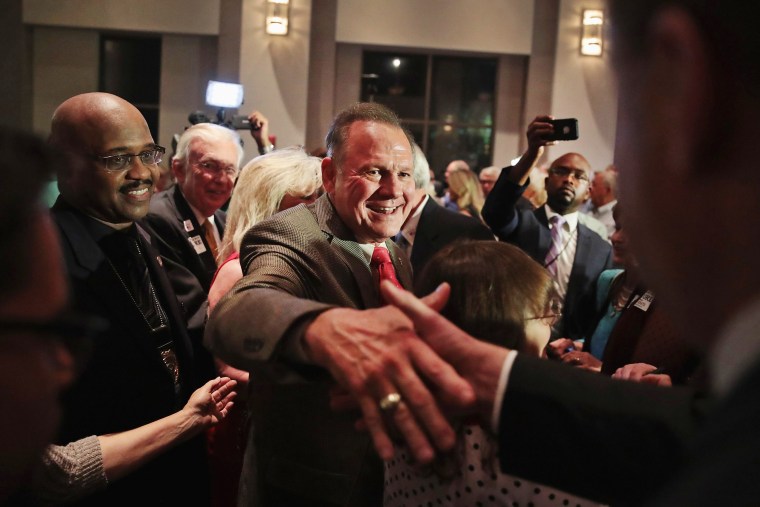First Read is your briefing from Meet the Press and the NBC Political Unit on the day's most important political stories and why they matter.
WASHINGTON — Move over Virginia and New Jersey, and say hello to Alabama, where the special U.S. Senate election between Republican Roy Moore and Democrat Doug Jones takes place a month from now on December 12.
The question we’ve been asking: How much will national Democrats play in the race, given their success Tuesday — but also given the fact that President Trump won Alabama by a whopping 28 points in 2016, 62 percent to 34 percent?
The answer we’ve been getting: Any chance that Jones has to win — 10 percent? 20 percent? — gets diminished the more that Democrats nationalize the contest, even if it’s to make the controversial Roy Moore a household name. National Democrats will pour money into getting out the vote and other behind-the-scenes activities, but don’t expect any party TV ads or high-profile national surrogates on the campaign trail.
“Doug’s undeniably the underdog; it’s an uphill battle,” DNC Chair Tom Perez said on “MTP Daily” yesterday. “And I’m confident he’ll keep fighting.” (A new poll has Moore leading Jones by 11 points, 51 percent to 40 percent.)
When one of us asked Perez about any ads or high-profile national help Democrats might send Jones’ way, he responded, “We didn’t increase our investments in state parties because we thought that we should throw money away. We increased our investments in state parties because we wanted to make sure that everyone in every state can win.”
But can Jones win? On the one hand, he has a lot of advantages that past southern Democrats haven’t had:
- He’s had Alabama’s airwaves all to himself the past month;
- He’s airing TV ads that make it hard to tell he’s a Democrat (“I can work with Republicans better than Roy Moore can work with anyone,” he says to camera in one ad);
- Moore is a controversial figure who isn’t the favorite of Alabama’s business community;
- It will be a low-turnout election in December;
- And the overall political environment can’t get much better for Democrats.
On the other hand, this is Alabama. But if Democrats really want to make a political statement, having Jones win — or get close to it — would do the trick.
National Democrats are sending every signal that they’re not trying to directly intervene in this race, and you can understand that strategy. But can you truly be a NATIONAL party if you hide? Symbolically, it sends the message that you can’t compete.
One big difference between the 2017 Virginia race and the 2018 midterms
There was no talk about Nancy Pelosi: With all of the talk of what Tuesday’s results in Virginia might mean for the 2018 midterms, remember that this was a gubernatorial race where Republican Ed Gillespie never introduced a national Democratic bogeyman or bogeywoman in his TV ads. There was no Nancy Pelosi, Chuck Schumer or Hillary Clinton – which won’t be the case next year.
And here’s a reminder from this week’s NBC/WSJ “Trump Counties” poll on the most popular/least popular politicians in the counties that fueled Trump’s win in 2016:
- Obama: 48 percent positive, 37 percent negative (+11)
- Sanders: 42 percent positive, 31 percent negative (+11)
- Trump: 44 percent positive, 45 percent negative (-1)
- Republican Party: 31 percent positive, 40 percent negative (-9)
- Democratic Party: 27 percent positive, 40 percent negative (-13)
- Mitch McConnell: 11 percent positive, 35 percent negative (-24)
- Nancy Pelosi: 16 percent positive, 44 percent negative (-28)
- Hillary Clinton: 23 percent positive, 60 percent negative (-37)
Trump: “I don’t blame China” when it comes to trade
During the 2016 election, then-candidate Donald Trump talked about China this way: "We can't continue to allow China to rape our country, and that's what they're doing."
But here he was as president while in China: today “Both the United States and China will have a more prosperous future if we can achieve a level economic playing field [on trade]. “Right now, unfortunately, it is a very one-sided and unfair one. But — but I don't blame China. After all, who can blame a country for being able to take advantage of another country for the benefit of its citizens? I give China great credit.”
Trump went on to say that he blames past America presidents. “I do blame past administrations for allowing this out-of-control trade deficit to take place and to grow. We have to fix this because it just doesn't work for our great American companies, and it doesn't work for our great American workers.”
By the way, Trump and Xi didn’t take questions from reporters — a break from precedent set by the last three American presidents who pressed their Chinese counterparts to allow exchanges with reporters, as NBC’s Peter Alexander reported on “Today” this morning.
It sends an awful message that an American president, while overseas, isn’t standing up for American freedoms.
The Democrat-vs.-Republican age gap keeps getting wider
Turning back to Tuesday’s race in Virginia, the age gap between Democrat Ralph Northam and Republican Ed Gillespie was striking:
- Ages 18-29: Northam 69 percent, Gillespie 30 (+39)
- Ages 30-44: Northam 61 percent, Gillespie 37 (+24)
- Ages 45-64: Gillespie 50 percent, Northam 49 percent (-1)
- Ages 65 and older: Gillespie 53, Northam 47 percent (-6).
Ralph Northam is no Barack Obama, but he was winning those 18-29 by a LARGER margin than Obama did in 2012. That is a big long-term problem for the GOP.
One final point on Virginia: Northam is indeed the Rodney Dangerfield of political candidates. Tom Perriello received tons of national attention in the 2017 primary, but Northam beat him by double digits. And with national Democrats and pundits questioning Northam’s campaign tactics, he beat Gillespie by nine points on Election Day.



